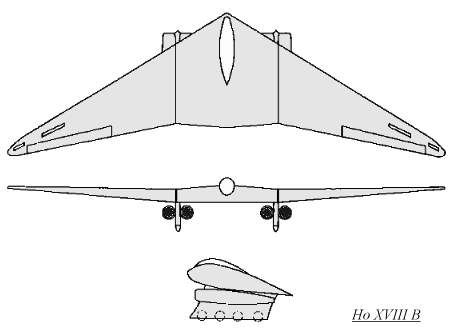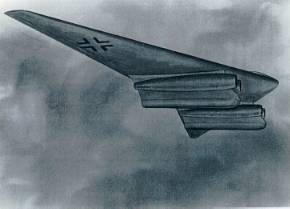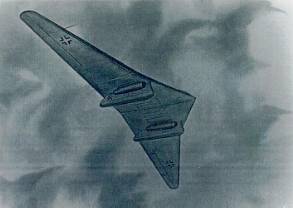 After being dissatisfied with the committee designed Ho
XVIII A, Reimar Horten redesigned the flying wing Amerika Bomber.
The proposed Ho XVIII B had a three man crew which sat upright in a bubble-type
canopy near the apex of the wing. There were two fixed main landing gear
assemblies with two He S 011 turbojets mounted to each side. During flight,
the tires would be covered by doors to help cut down on air resistance
and drag, a nose wheel being considered not necessary. Overall, the aircraft
would have weighed about 35 tons fully loaded. Fuel was to be stored in
the wing so that no auxiliary fuel tanks would be required. It was estimated
that the Ho XVIII B would have a range of 11000 km (6835 miles), a service
ceiling of 16 km (52492 feet) and a round-trip endurance of 27 hours. Although
armament was considered unnecessary, Reimar Horten proposed that two MK
108 30mm cannon could be mounted directly below the cockpit. It was decided
that construction was to be done in two bomb-proof hangers near Kala, which
had concrete roofs 5.6 meters (18.4 feet) thick. In addition, extra long
runways had been constructed so the aircraft could be test flown there
too. Work was supposed to start immediately, and the RLM expected the Ho
XVIII B to be built by the fall of 1945, which Reimar Horten reported to
be impossible. At any rate, Germany surrendered two months later before
construction could begin.
After being dissatisfied with the committee designed Ho
XVIII A, Reimar Horten redesigned the flying wing Amerika Bomber.
The proposed Ho XVIII B had a three man crew which sat upright in a bubble-type
canopy near the apex of the wing. There were two fixed main landing gear
assemblies with two He S 011 turbojets mounted to each side. During flight,
the tires would be covered by doors to help cut down on air resistance
and drag, a nose wheel being considered not necessary. Overall, the aircraft
would have weighed about 35 tons fully loaded. Fuel was to be stored in
the wing so that no auxiliary fuel tanks would be required. It was estimated
that the Ho XVIII B would have a range of 11000 km (6835 miles), a service
ceiling of 16 km (52492 feet) and a round-trip endurance of 27 hours. Although
armament was considered unnecessary, Reimar Horten proposed that two MK
108 30mm cannon could be mounted directly below the cockpit. It was decided
that construction was to be done in two bomb-proof hangers near Kala, which
had concrete roofs 5.6 meters (18.4 feet) thick. In addition, extra long
runways had been constructed so the aircraft could be test flown there
too. Work was supposed to start immediately, and the RLM expected the Ho
XVIII B to be built by the fall of 1945, which Reimar Horten reported to
be impossible. At any rate, Germany surrendered two months later before
construction could begin.
Span: 40 m (131' 4") Length: unknown Max. Speed: 850 km/h (528 mph)

